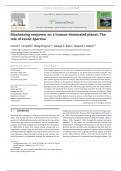Exam (elaborations)
Maximizing empower on a human-dominated planet: The role of exotic Spartina
- Course
- Institution
Maximizing empower on a human-dominated planet: The role of exotic Spartina Daniel E. Campbell a , Hong-Fang Lub,∗ , George A. Knoxc , Howard T. Odumd,1 a USEPA, Office of Research and Development, National Health and Environmental Effects Research Laboratory, Atlantic Ecology Division, Na...
[Show more]



